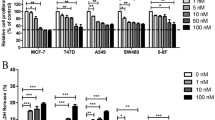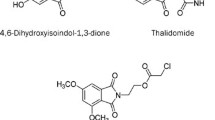Abstract
Targeting angiogenesis is considered an effective strategy for treating the expansion and metastasis of tumors. The aim of this study is to assess the effects of perifosine, an inhibitor of Akt, on cell proliferation, apoptosis, angiogenesis, and VEGF-induced cell migration in cultured human umbilical vein endothelial cells (HUVECs) in vitro. MTT and cell cycle analysis results indicated that perifosine inhibited the growth of HUVECs in a dose-dependent manner, arrested cell cycle progression at the G2 phase with regulation the expression of p21 and cyclinB1. Apoptosis induced by the higher concentrations of perifosine in HUVECs was also observed. In addition, tube formation of HUVECs and VEGF-induced cell migration were markedly inhibited by perifosine. Western blotting analysis of cell signaling molecules indicated that perifosine inhibited ERK and p38 phosphorylation in HUVECs. These results suggest that perifosine exerts anti-angiogenic activity in HUVECs and is a promising agent for treatment of angiogenesis related-diseases.






Similar content being viewed by others
References
Folkman J (2006) Angiogenesis. Annu Rev Med 57:1–18. doi:10.1146/annurev.med.57.121304.131306
Libert N, Tourtier JP, Védrine L, Chargari C (2010) Inhibitors of angiogenesis: new hopes for oncologists new challenges for anesthesiologists. Anesthesiology 113(3):704–712. doi:10.1097/ALN.0b013e3181ed098d
Cook KM, Figg WD (2010) Angiogenesis inhibitors: current strategies and future prospects. CA Cancer J Clin 60(4):222–243. doi:10.3322/caac.20075
Pinto A, Redondo A, Zamora P, Castelo B, Espinosa E (2010) Angiogenesis as a therapeutic target in urothelial carcinoma. Anticancer Drugs 21(10):890–896. doi:10.1097/CAD.0b013e32833e83b2
He L, Wu Y, Lin L, Wang J, Wu Y, Chen Y, Yi Z, Liu M, Pang X (2011) Hispidulin, a small flavonoid molecule, suppresses the angiogenesis and growth of human pancreatic cancer by targeting vascular endothelial growth factor receptor 2-mediated PI3K/Akt/mTOR signaling pathway. Cancer Sci 102(1):219–225. doi:10.1111/j.1349-7006.2010.01778.x
Chetty C, Lakka SS, Bhoopathi P, Rao JS (2010) MMP-2 alters VEGF expression via alphaVbeta3 integrin-mediated PI3K/AKT signaling in A549 lung cancer cells. Int J Cancer 127(5):1081–1095. doi:10.1002/ijc.25134
Ikegami D, Akiyama H, Suzuki A, Nakamura T, Nakano T, Yoshikawa H, Tsumaki N (2011) Sox9 sustains chondrocyte survival and hypertrophy in part through Pik3ca–Akt pathways. Development 138(8):1507–1519. doi:10.1242/dev.057802
Khalil A, Morgan RN, Adams BR, Golding SE, Dever SM, Rosenberg E, Povirk LF, Valerie K (2011) ATM-dependent ERK signaling via AKT in response to DNA double-strand breaks. Cell Cycle 10(3):481–491
Kloo B, Nagel D, Pfeifer M, Grau M, Düwel M, Vincendeau M, Dörken B, Lenz P, Lenz G, Krappmann D (2011) Critical role of PI3K signaling for NF-kappaB-dependent survival in a subset of activated B-cell-like diffuse large B-cell lymphoma cells. Proc Natl Acad Sci USA 108(1):272–277. doi:10.1073/pnas.1008969108
Jiang BH, Liu LZ (2009) PI3K/PTEN signaling in angiogenesis and tumorigenesis. Adv Cancer Res 102:19–65. doi:10.1016/S0065-230X(09)02002-8
LaRusch GA, Mahdi F, Shariat-Madar Z, Adams G, Sitrin RG, Zhang WM, McCrae KR, Schmaier AH (2010) Factor XII stimulates ERK1/2 and Akt through uPAR, integrins, and the EGFR to initiate angiogenesis. Blood 115(24):5111–5120. doi:10.1182/blood-2009-08-236430
Fei HR, Chen G, Wang JM, Wang FZ (2010) Perifosine induces cell cycle arrest and apoptosis in human hepatocellular carcinoma cell lines by blockade of Akt phosphorylation. Cytotechnology 62(5):449–460. doi:10.1007/s10616-010-9299-4
Fu L, Kim YA, Wang X, Wu X, Yue P, Lonial S, Khuri FR, Sun SY (2009) Perifosine inhibits mammalian target of rapamycin signaling through facilitating degradation of major components in the mTOR axis and induces autophagy. Cancer Res 69(23):8967–8976. doi:10.1158/0008-5472.CAN-09-2190
Kumar A, Fillmore HL, Kadian R, Broaddus WC, Tye GW, Van Meter TE (2009) The alkylphospholipid perifosine induces apoptosis and p21-mediated cell cycle arrest in medulloblastoma. Mol Cancer Res 7(11):1813–1821. doi:10.1158/1541-7786.MCR-09-0069
Park HJ, Zhang Y, Georgescu SP, Johnson KL, Kong D, Galper JB (2006) Human umbilical vein endothelial cells and human dermal microvascular endothelial cells offer new insights into the relationship between lipid metabolism and angiogenesis. Stem Cell Rev 2(2):93–102. doi:10.1007/s12015-006-0015-x
Wu P, Hu YZ (2010) PI3K/Akt/mTOR pathway inhibitors in cancer: a perspective on clinical progress. Curr Med Chem 17(35):4326–4341
Falasca M (2010) PI3K/Akt signalling pathway specific inhibitors: a novel strategy to sensitize cancer cells to anti-cancer drugs. Curr Pharm Des 16(12):1410–1416
Leonard R, Hardy J, van Tienhoven G, Houston S, Simmonds P, David M, Mansi J (2001) Randomized, double-blind, placebo-controlled, multicenter trial of 6% miltefosine solution, a topical chemotherapy in cutaneous metastases from breast cancer. J Clin Oncol 19:4150–4159
Tang JY, Li S, Li ZH, Zhang ZJ, Hu G, Cheang LC, Alex D, Hoi MP, Kwan YW, Chan SW, Leung GP, Lee SM (2010) Calycosin promotes angiogenesis involving estrogen receptor and mitogen-activated protein kinase (MAPK) signaling pathway in zebrafish and HUVEC. PLoS One 5(7):e11822. doi:10.1371/journal.pone.0011822
Huang D, Ding Y, Luo WM, Bender S, Qian CN, Kort E, Zhang ZF, VandenBeldt K, Duesbery NS, Resau JH, Teh BT (2008) Inhibition of MAPK kinase signaling pathways suppressed renal cell carcinoma growth and angiogenesis in vivo. Cancer Res 68(1):81–88. doi:10.1158/0008-5472.CAN-07-5311
Hiarini F, DelSole M, Mongiorgi S, Gaboardi GC, Cappellini A, Mantovani I, Follo MY, McCubrey JA, Martelli AM (2008) The novel Akt inhibitor, perifosine, induces caspase-dependent apoptosis and downregulates P-glycoprotein expression in multidrug-resistant human T-acute leukemia cells by a JNK-dependent mechanism. Leukemia 22(6):1106–1116. doi:10.1038/leu.2008.79
Acknowledgments
This study was supported by grants from the National Natural Science Foundation of China (No 30800422).
Author information
Authors and Affiliations
Corresponding author
Rights and permissions
About this article
Cite this article
Wang, F.Z., Fei, H.R., Li, X.Q. et al. Perifosine as potential anti-cancer agent inhibits proliferation, migration, and tube formation of human umbilical vein endothelial cells. Mol Cell Biochem 368, 1–8 (2012). https://doi.org/10.1007/s11010-011-0986-z
Received:
Accepted:
Published:
Issue Date:
DOI: https://doi.org/10.1007/s11010-011-0986-z




